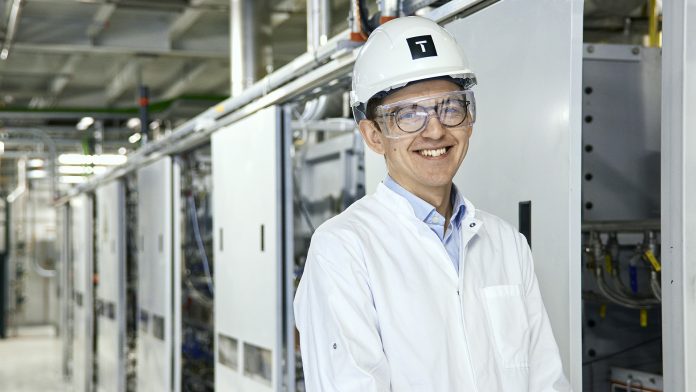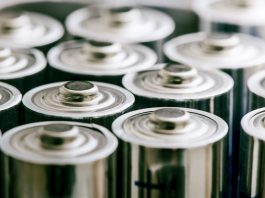The inauguration of a new large-scale LNMO material industrialisation pilot in Frederikssund, Denmark, in February, marked a significant milestone for Topsoe, and it is only the beginning.
Topsoe’s LNMO material production industrialisation pilot is up and running. This is exciting progress in the development of the Li-ion batteries so crucial to our green future, with Topsoe committed to high-quality, efficient products that not only meet but exceed customer needs.
With one supply agreement already in place, Jonathan Højberg, Research and Development Director for Batteries, is rightly optimistic for the future, with commercialisation only a stone’s throw away. Jonathan Højberg elaborates on the project, its significance in the sector, and Topsoe’s commitment to excellence.
What have been the main drivers for the project and the expected outcome?
Topsoe has developed LNMO cathode active material for Li-ion batteries for the past ten years. Specifically, we have developed materials with high-phase purity and superior morphology that enable easy processing and high electrode energy density. In parallel, we have worked on ramping up the production process to an industrial scale. The industrialisation pilot with a design capacity of 200 tonnes/year was inaugurated in February 2024 and is an important milestone in our strategy to deliver to the market.
Although scaling of material production is a core competence in Topsoe, at an early stage, we identified a need to demonstrate production-at-scale for two main reasons. First, it enables us to meet increasing demand from customer qualification programmes. Second, we can test key equipment and fine-tune the design of the future full-scale production.
What are the advantages Topsoe sees in LNMO compared to other cathode-active materials?
LNMO is a multipurpose, electrode-active material optimised for low cost and high energy and fits into electric vehicle (EV) batteries. It is suitable for demanding applications that require fast charge or discharge. Batteries based on our LNMO material will be fully competitive globally and help build a Europe-based battery value chain. We see the current combination of technological maturity and growth in the relevant market segments as a significant driver of interest in LNMO.
What advancements or optimisations does the industrialisation pilot aim to achieve?
The industrialisation pilot has a few features that I would like to highlight. First, it is unique in its flexibility to use various raw materials. This is key to ensuring that we base our full-scale production on the optimal combination of capital expenditure (CapEx) and operating expenditure (OpEx). Second, we have combined industry-standard processes with several Topsoe processes that allow us to unlock the full potential of the LNMO technology. Third, all processes are electrified to enable the production of LNMO with low CO2 emissions.
A key deliverable of the first year of operation is validation by confirming that production capacity, product quality and product variation are as planned and designed. Additionally, the pilot’s flexibility will be used to validate raw materials and processes that will guide the design of full-scale production.
What key performance criteria must the LNMO cathode active material meet, and how will the pilot contribute to meeting these criteria?
The LNMO cathode active material must fulfil a set of design parameters, such as morphology and impurity levels. The industrialisation plant is designed to ensure low variability in product quality, and confirming this ability will be a priority.
What quality measures are in place in the industrialisation pilot, and how do they align with the Topsoe approach?
To ensure high-quality standards, we adhere to a management system that meets the stringent requirements of ISO 9001:2015. This system ensures we fully understand customer technical and commercial needs and regularly assess customer satisfaction.
Our commitment to quality is deeply embedded in our company mission at Topsoe, ‘to perfect chemistry for a better world.’ We are steadfast in pursuing continuous improvement, optimising processes to enhance safety, quality, productivity, timeliness, and cost-effectiveness. These priorities have been at the heart of the industrialisation pilot since the first stages.
Innovation is at the heart of our approach: We aim to provide solutions within batteries that meet and exceed the needs of our customers. Our production processes are designed to be efficient and secure, always in compliance with all regulatory requirements.
How will the data and insights gathered from the pilot be utilised to improve the LNMO cathode active material production process further?
The complete testing of processes and raw materials is key to ensuring that we design our full-scale production with an optimal combination of CapEx, OpEx, and quality. We must deliver the required quality without overengineering. This will ensure we stay competitive and meet customer needs.
What does the commercial rollout plan look like from here?
We are already looking beyond our industrialisation pilot and have finalised a conceptual design for a future large-scale production facility, which is an exciting step forward. We will use the learnings to fine-tune the design as soon as we have successfully demonstrated and commercialised the material from the industrialisation pilot.
An important milestone in this journey was signing a supply agreement with Norway-based Morrow Batteries. The agreement enables Morrow to develop battery cell chemistries based on our innovative LNMO material with a path towards industrialisation.
We are seeking and relying on strong collaborations and partnerships and exploring potential new pathways within the entire value chain for the years to come. We will work with partners to ensure sustainably produced raw materials, better battery cell components, and high-performing cells. We see this collaboration as a prerequisite for success, enabling us to be an important player in the market for cathode active materials.
Please note, this article will also appear in the seventeenth edition of our quarterly publication.









